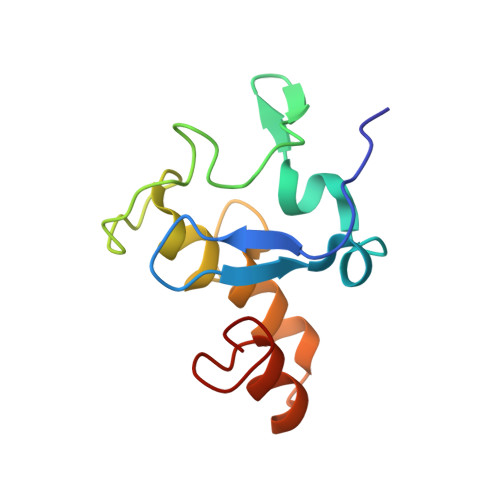Redox-coupled conformational alternations in cytochrome c(3) from D. vulgaris Miyazaki F on the basis of its reduced solution structure.
Harada, E., Fukuoka, Y., Ohmura, T., Fukunishi, A., Kawai, G., Fujiwara, T., Akutsu, H.(2002) J Mol Biol 319: 767-778
- PubMed: 12054869
- DOI: https://doi.org/10.1016/S0022-2836(02)00367-4
- Primary Citation of Related Structures:
1IT1 - PubMed Abstract:
Heteronuclear NMR spectroscopy was performed to determine the solution structure of (15)N-labeled ferrocytochrome c(3) from Desulfovibrio vulgaris Miyazaki F (DvMF). Although the folding of the reduced cytochrome c(3) in solution was similar to that of the oxidized one in the crystal structure, the region involving hemes 1 and 2 was different. The redox-coupled conformational change is consistent with the reported solution structure of D. vulgaris Hildenborough ferrocytochrome c(3), but is different from those of other cytochromes c(3). The former is homologous with DvMF cytochrome c(3) in amino acid sequence. Small displacements of hemes 1 and 2 relative to hemes 3 and 4 were observed. This observation is consistent with the unusual behavior of the 2(1)CH(3) signal of heme 3 reported previously. As shown by the (15)N relaxation parameters of the backbone, a region between hemes 1 and 2 has more flexibility than the other regions. The results of this work strongly suggest that the cooperative reduction of hemes 1 and 2 is based on the conformational changes of the C-13 propionate of heme 1 and the aromatic ring of Tyr43, and the interaction between His34 and His 35 through covalent and coordination bonds.
Organizational Affiliation:
Institute for Protein Research, Osaka University, 3-2 Yamadaoka, Suita, Osaka 565-0871, Japan.















